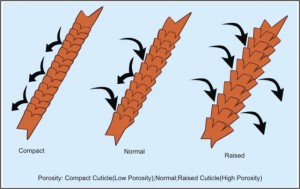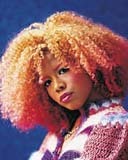Pages
- Home
- Finding Your Hair's Properties & Type
- Biography/Hair Journey
- What is an Afro-Latino Anyway?
- Baby and Toddler Natural/Curly Hair Care
- List of Drugstore Curly Girl Approved Products
- Protective Styles
- Protein Sensitivity
- Curly Girl Method/Essentials
- My Current Products/Routine
- The Weather & Your Hair
Finding Your Hair's Properties & Type
I know I probably sound like a broken record by now, but knowing your hair’s properties can be the difference in your hair’s success, or looking a mess. These properties will be the key in knowing what types of products to use in your hair. Because once again, what works for one person doesn’t always work for someone else. So here is a break down on everything you need to know about your hair’s properties.
Porosity:
Porosity is basically how well your hair absorbs AND loses moisture. High Porosity hair has holes in it due to damage from heat or chemicals. Some curlies even have high porosity hair naturally. High porosity hair absorbs AND loses moisture easily, due to all of the holes in the cuticle. Normal Porosity hair usually has no problems absorbing OR losing moisture. Low Porosity hair (what I have), has a very tightly bound cuticle layer, and has a hard time absorbing moisture. It usually does not have a problem with losing moisture. People with low-porosity hair sometimes have a problem with using proteins. But one problem also seen with this hair type is that if you let it get dry, it is very hard to restore moisture. After my recent Protein OD, it took me at least a month to restore moisture back to my hair. My hair is still somewhat dry from it, but its MUCH better than before.
So how do you know what type of porosity you have? Many suggest sliding your figure up your strand to see if it feels slick or rough. I personally do not suggest this method. It is said that if your fingers slide up and it feels slick that you have low porosity hair, and if it feels rough that you have high porosity hair. The problem with this test that it does not take into account that hair that is coarse will ALWAYS feel slightly rough. I had a hard time with this since I have slightly coarse hair. My hair is Low Porosity, but from the test you might have thought that I have high porosity hair. The best way in my opinion is to take several clean strands from different sections of your head, and take a bowl of water. Put the hair in the water for 2 minutes. If they float the entire time you have low porosity hair, if they sink half way and float half way, you have normal porosity hair, and if they sink then you have high porosity hair.
High Porosity and Low porosity people should adjust their routine to this. People with high Porosity hair can use protein to mend the holes (temporarily), and will also benefit from either doing cool rinses when rinsing out conditioners and deep conditioners, or doing the apple cider vinegar rinse. Low Porosity hair will benefit from either starting off the process using warm water, or doing the baking soda scrub to clarify the hair AND open the cuticle. When rinsing out conditioners and deep conditioners cool water or an Apple Cider Vinegar (ACV) rinse should always be used to close the cuticle again. When doing the baking soda scrub the ACV should ALWAYS be used afterward. Also, when doing deep treatments low porosity hair will also benefit from either overnight deep treatments to allow a lot of time for the deep treatment to penetrate, or using heat to allow the cuticle to open and absorb the moisture.
Texture:
Texture is important because each texture needs different things. There are three basic textures: Fine, Medium, and Coarse. Once again, you can have different textures on your head. I have both medium and coarse textures. Fine hair prefers more protein than moisture, since fine hair lacks in protein. Medium hair can do well with a fair amount of moisture and protein. Those who are medium should consider themselves very lucky! Coarse hair usually creates a great amount of protein naturally, so adding protein can cause problems. Coarse hair loves a significant amount of moisture. Lots of emollients and humectants should be used.
How do you figure out your texture? It’s very simple. Take a few strands from different areas of your head, and look at them under a light. If your hairs are barely there, you are fine. If your hair is wiry and substantial, then you are coarse. If you are in between then you are medium.
Elasticity:
Knowing your elasticity is very crucial as well. Elasticity can either be low, normal, or high. Elasticity is the way of knowing whether your hair is balanced, or lacks moisture or protein. When elasticity is low, moisture is needed. When it is normal your hair has a perfect balance of protein and moisture. When elasticity is low the hair is lacking in protein.
To test this once again take a few strands of hair from all over your head. hold each piece securely and stretch the hair. If the hair barely stretches and breaks, your hair low elasticity and you need moisture! If your hair stretches a fair amount and bounce back, you are in balance. If your hair stretches, and stretches, and stretchhhessss and doesn’t bounce back or it breaks, you need protein. Knowing your elasticity is the key to knowing what your hair needs if it is acting up.
Density:
I wouldn’t say density is very important, but its a good thing to know. Density is the amount of hairs on your head. You can have low, medium, or high density. Low density means that you have very few hairs on your head. Medium density is a normal amount of hair on your head. High density is a lot of hair on your head. Someone can have fine hair and high density, and it can appear that they have very thick hair, when they just have a lot of hair. I am unsure of my denisty, but I think it is medium density.
I hope all of this info has helped you learn more about what your hair needs! If you try these tests and you still unsure of your hair’s properties then you can always send your hair off for the curl analysis by curlwizard.com. That is how I figured out my hair’s properties. She also has an e-book that has great info in it! Knowing my properties has improved my hair by probably about 75%!!
Picture Source: Kisforkinky.com
Finding your Hair Type:
Even though your hair’s properties are the most important thing when considering products, it might also be helpful to know your hair type. There are some issues stemming from hair types. For example, many 3c’s have problems getting protective styles to hold, and some 4b’s would like to know methods to achieve more definition. You may not necessarily fit into one category. Here is a rundown of the Andre Walker hair types that I found on naturallycurly.com. I have only included 3c and up since this site is geared more towards afro-latinas and natural hair.
3C: Pencil Diameter, S pattern when stretched, classified as “kinky-curly”
4a: Coffee Stirrer Diameter, S pattern when stretched
4b: Cotton like feel, No visible curl pattern, Z pattern when stretched
All of these types of hair can have a wide range of properties. Finding your hair type in conjunction with knowing your hair’s properties will be essential in finding the best methods and products for YOUR hair.
All of these hair patterns benefit from protective styling and sealing (most of the time).
Picture Sources: Naturallycurly.com
Subscribe to:
Comments (Atom)




